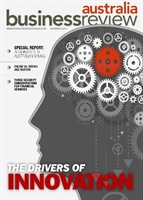Bruce Anderson. When we think of the word 'innovation,' the first concept that comes to mind is advances in technology. But how can innovation - in terms of better solutions, better products and better processes - be encouraged in any workplace?
Innovation is a key lever for growth - a top strategic priority for many organisations as they shift from crisis mode to recovery mode. As economic and competitive pressures increase, companies need competent leadership to engage their talent to work smarter and more productively.
This means being innovative - looking for better solutions, better products and better processes that address current and emerging needs that drive the company forward.
Failure to innovate means no risks are being taken, no new ideas implemented. Growth is not possible for companies who are simply maintaining the
status quo. But what is innovation? Where does it come from, and whose job is it?
Most corporate leaders understand that innovation is essential for survival in today's business world. However, the definition of "innovation" varies among business leaders.
In some cases, any change in product offering can be defined as "innovation," while other companies reserve the term for dramatic changes in product or process.
Some define innovation as creating competitive advantage in the marketplace by finding new ways to solve a customer problem or filling existing and emerging needs.
Regardless of different definitions, there are a number of common practices for promoting a culture of innovation:
Embrace Failure, but Learn QuicklyWhen business leaders model a tolerance for risk, others become more willing to take the chances needed to realise promising ideas.
It's important to learn from failure but in addition to accepting failure, innovative companies need to avoid perfectionism. The goal is to get the new offering to market as quickly as possible rather than to achieve perfection.
Knowing when to "pull the plug" is clearly an asset, and companies need to have clear guidelines for how much time and money to invest in innovation. It's important to distinguish between actual failure and a mere setback on the road to success.
Creativity is all about failure so don't punish mistakes - learn from them. Debriefing sessions held in an atmosphere that allows people to be comfortable help foster free discussions about times when things don't go as planned.
Provide the Right RewardsInnovation springs from individuals and teams as part of a creative process to solve problems and address existing and emerging needs. It's critical that organisations provide compensation structures and other rewards that encourage innovation across all functions of the organisation.
All employees should have an opportunity to improve how work gets done, create new and better ways to serve internal and external stakeholders, and improve efficiency and productivity.
Innovation can be recognised with financial incentives. But some of the best incentives can also come in the form of recognition from management and colleagues, as well as career development opportunities.
Some examples of rewards in innovative companies include:
- Rewarding people for working on an idea, even if it does not get to the execution stage.
- Holding brainstorming meetings without the organisation's senior figures to encourage people to verbalise their innovative ideas.
- Allowing employees to write and apply for research grants to carry out projects that are important to them.
- Holding weekly process improvement meetings that invite ideas from everyone in the company.
- Having formal recognition programs that include nominations and/or votes from colleagues, with innovation as one of the nomination categories.
Build a Diverse TeamDiversity goes beyond race and has moved past simple demographics. It can be defined much more broadly to include various ways in which groups of people differ significantly from other groups of people. You need people that are different than yourself in order to be successful.
To gain fresh perspectives and new ideas, leaders shouldn't necessarily hire someone who has been in the industry before. Companies seek smart people, who display talent and communication skills.
Foster Connections with External StakeholdersEmployees are not the only source of innovation. Inside and outside stakeholders are able to see the project with fresh eyes, assure that it meets customer needs, and will be invested in a positive outcome if they have been involved in the development and implementation processes.
Identify and Develop Leadership Competencies that Drive InnovationMany organisations develop leadership competency models to define the characteristics or behaviours that will drive innovation. Some of the competencies that are associated with driving innovation include emotional intelligence, social intelligence, analytical capabilities and technical competencies. Emotional skills and the ability to have a vision are ranked as some of the most important.
There is no single path to innovation; that path must originate in the minds of the organisation's executive leadership. The executive office isn't just the place where the buck stops. It's also the place where the future begins.
Source: http://www.businessreviewaustralia.com/technology/the-drivers-of-innovation  Profile
Profile  Client Snapshot
Client Snapshot  Tools
Tools  Resources
Resources  M-News
M-News  Contact
Contact
